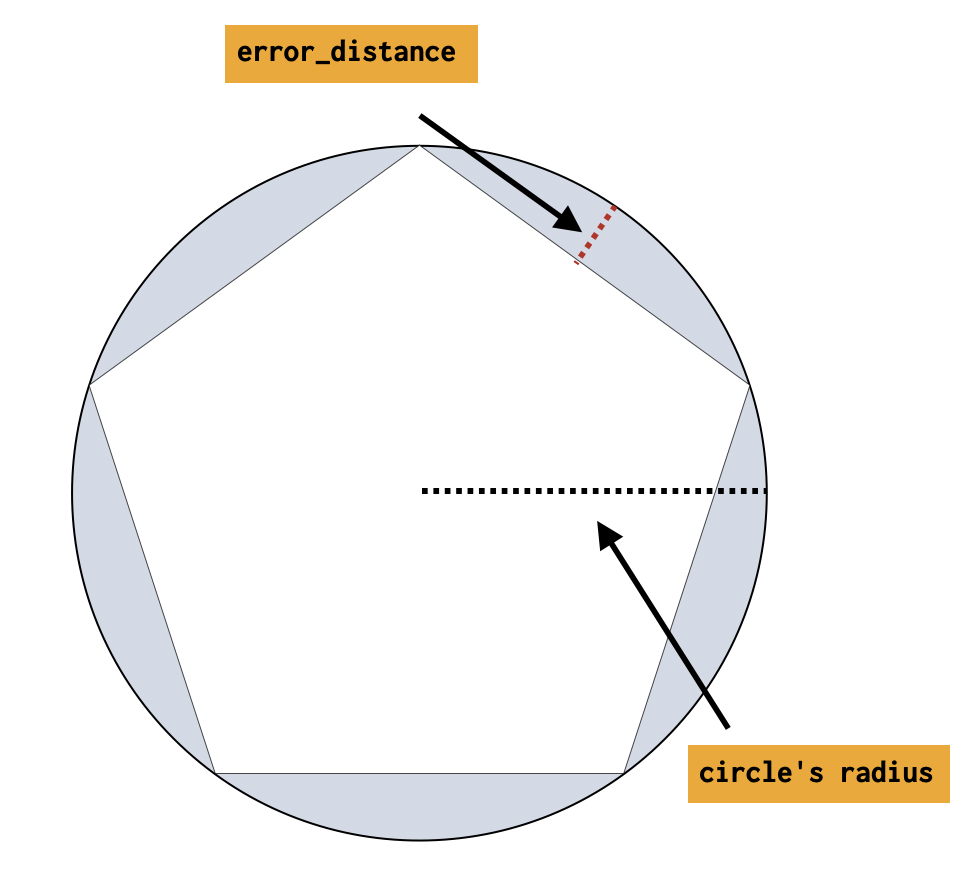圆形处理器
编辑圆形处理器
编辑将形状的圆形定义转换为逼近它们的规则多边形。
表 6. 圆形处理器选项
| 名称 | 必需 | 默认值 | 描述 |
|---|---|---|---|
|
是 |
- |
要解释为圆形的字段。可以是 WKT 格式的字符串,也可以是 GeoJSON 的映射。 |
|
否 |
|
要将多边形形状分配到的字段,默认情况下 |
|
否 |
|
如果 |
|
是 |
- |
从中心到边的结果内切距离与圆的半径之间的差值(对于 |
|
是 |
- |
处理圆形时要使用的字段映射类型: |
|
否 |
- |
处理器的描述。用于描述处理器的目的或其配置。 |
|
否 |
- |
有条件地执行处理器。请参阅有条件地运行处理器。 |
|
否 |
|
忽略处理器的失败。请参阅处理管道失败。 |
|
否 |
- |
处理处理器的失败。请参阅处理管道失败。 |
|
否 |
- |
处理器的标识符。用于调试和指标。 |

resp = client.indices.create(
index="circles",
mappings={
"properties": {
"circle": {
"type": "geo_shape"
}
}
},
)
print(resp)
resp1 = client.ingest.put_pipeline(
id="polygonize_circles",
description="translate circle to polygon",
processors=[
{
"circle": {
"field": "circle",
"error_distance": 28,
"shape_type": "geo_shape"
}
}
],
)
print(resp1)
response = client.indices.create(
index: 'circles',
body: {
mappings: {
properties: {
circle: {
type: 'geo_shape'
}
}
}
}
)
puts response
response = client.ingest.put_pipeline(
id: 'polygonize_circles',
body: {
description: 'translate circle to polygon',
processors: [
{
circle: {
field: 'circle',
error_distance: 28,
shape_type: 'geo_shape'
}
}
]
}
)
puts response
const response = await client.indices.create({
index: "circles",
mappings: {
properties: {
circle: {
type: "geo_shape",
},
},
},
});
console.log(response);
const response1 = await client.ingest.putPipeline({
id: "polygonize_circles",
description: "translate circle to polygon",
processors: [
{
circle: {
field: "circle",
error_distance: 28,
shape_type: "geo_shape",
},
},
],
});
console.log(response1);
PUT circles
{
"mappings": {
"properties": {
"circle": {
"type": "geo_shape"
}
}
}
}
PUT _ingest/pipeline/polygonize_circles
{
"description": "translate circle to polygon",
"processors": [
{
"circle": {
"field": "circle",
"error_distance": 28.0,
"shape_type": "geo_shape"
}
}
]
}
使用上述管道,我们可以尝试将文档索引到 circles 索引中。圆形可以用 WKT 圆或 GeoJSON 圆表示。生成的多边形将使用与输入圆形相同的格式表示和索引。WKT 将转换为 WKT 多边形,而 GeoJSON 圆形将转换为 GeoJSON 多边形。
不支持包含极点的圆形。
示例:以众所周知的文本定义的圆形
编辑在此示例中,索引了以 WKT 格式定义的圆形
resp = client.index(
index="circles",
id="1",
pipeline="polygonize_circles",
document={
"circle": "CIRCLE (30 10 40)"
},
)
print(resp)
resp1 = client.get(
index="circles",
id="1",
)
print(resp1)
response = client.index(
index: 'circles',
id: 1,
pipeline: 'polygonize_circles',
body: {
circle: 'CIRCLE (30 10 40)'
}
)
puts response
response = client.get(
index: 'circles',
id: 1
)
puts response
const response = await client.index({
index: "circles",
id: 1,
pipeline: "polygonize_circles",
document: {
circle: "CIRCLE (30 10 40)",
},
});
console.log(response);
const response1 = await client.get({
index: "circles",
id: 1,
});
console.log(response1);
PUT circles/_doc/1?pipeline=polygonize_circles
{
"circle": "CIRCLE (30 10 40)"
}
GET circles/_doc/1
上述索引请求的响应
{
"found": true,
"_index": "circles",
"_id": "1",
"_version": 1,
"_seq_no": 22,
"_primary_term": 1,
"_source": {
"circle": "POLYGON ((30.000365257263184 10.0, 30.000111397193788 10.00034284530941, 29.999706043744222 10.000213571721195, 29.999706043744222 9.999786428278805, 30.000111397193788 9.99965715469059, 30.000365257263184 10.0))"
}
}
示例:以 GeoJSON 定义的圆形
编辑在此示例中,索引了以 GeoJSON 格式定义的圆形
resp = client.index(
index="circles",
id="2",
pipeline="polygonize_circles",
document={
"circle": {
"type": "circle",
"radius": "40m",
"coordinates": [
30,
10
]
}
},
)
print(resp)
resp1 = client.get(
index="circles",
id="2",
)
print(resp1)
response = client.index(
index: 'circles',
id: 2,
pipeline: 'polygonize_circles',
body: {
circle: {
type: 'circle',
radius: '40m',
coordinates: [
30,
10
]
}
}
)
puts response
response = client.get(
index: 'circles',
id: 2
)
puts response
const response = await client.index({
index: "circles",
id: 2,
pipeline: "polygonize_circles",
document: {
circle: {
type: "circle",
radius: "40m",
coordinates: [30, 10],
},
},
});
console.log(response);
const response1 = await client.get({
index: "circles",
id: 2,
});
console.log(response1);
PUT circles/_doc/2?pipeline=polygonize_circles
{
"circle": {
"type": "circle",
"radius": "40m",
"coordinates": [30, 10]
}
}
GET circles/_doc/2
上述索引请求的响应
{
"found": true,
"_index": "circles",
"_id": "2",
"_version": 1,
"_seq_no": 22,
"_primary_term": 1,
"_source": {
"circle": {
"coordinates": [
[
[30.000365257263184, 10.0],
[30.000111397193788, 10.00034284530941],
[29.999706043744222, 10.000213571721195],
[29.999706043744222, 9.999786428278805],
[30.000111397193788, 9.99965715469059],
[30.000365257263184, 10.0]
]
],
"type": "Polygon"
}
}
}
关于准确性的说明
编辑表示圆形的 多边形的准确性定义为 error_distance。此差值越小,多边形就越接近完美的圆形。
下表旨在帮助捕获在给定不同输入的情况下,圆的半径如何影响多边形的边数。
最小边数为 4,最大边数为 1000。